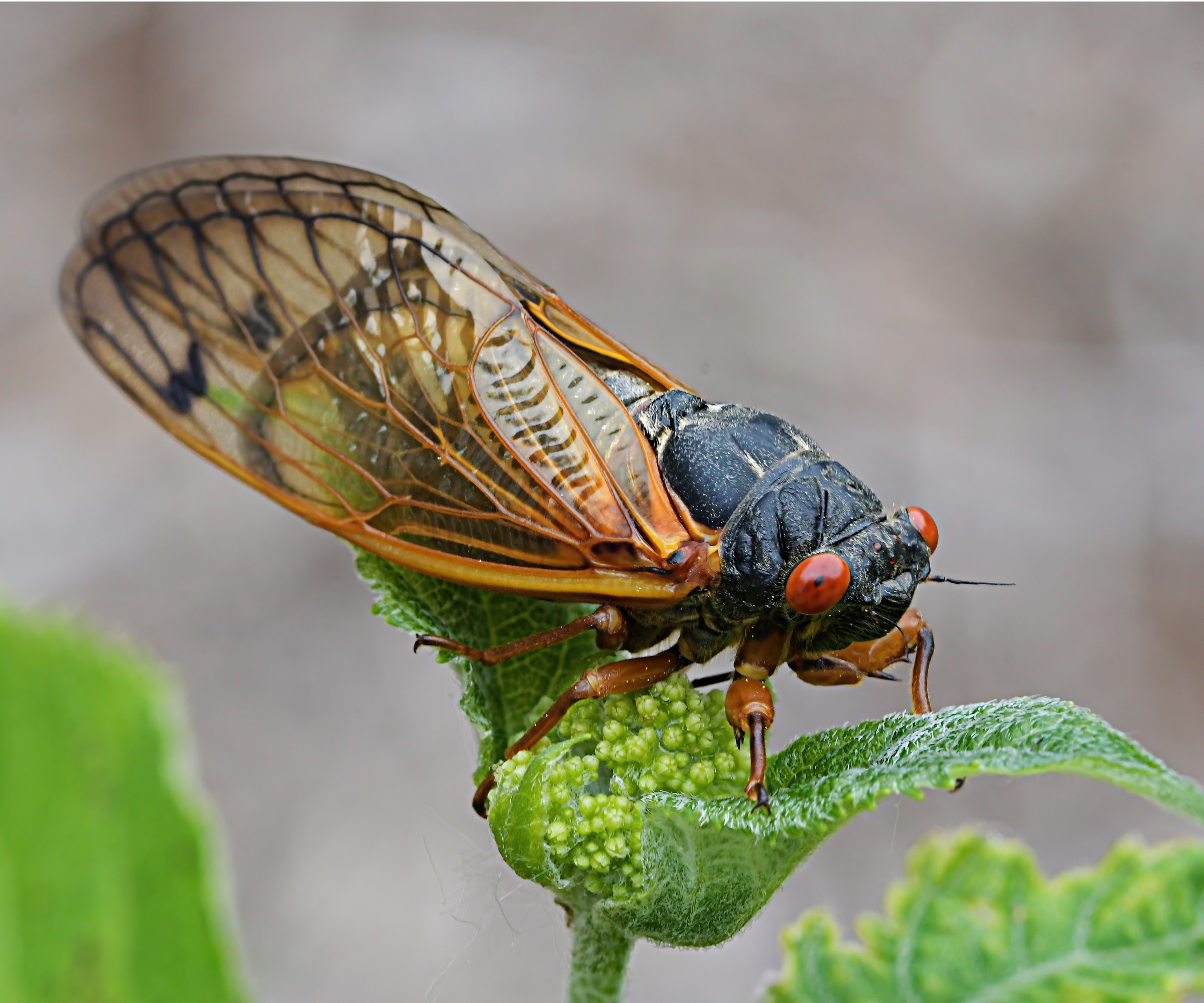
You may be wondering why there are so many cicadas in your area lately. Unlike the annual cicadas that appear, these loud cyclical pests are spawning out of the ground to mate before their long lives end.
This year marks the end of the Great Eastern Brood's 17-year life cycle, now the weather and soil are warm enough. Here, gardening and pest experts reveal why they're appearing in large numbers, how long periodical cicada swarms will last, and any preparations you can make to protect your home and yard.
Learning how to repel cicadas from your yard can be a great help, but in most cases, it's not possible to eradicate or avoid them.
Why are there so many cicadas around lately?
More cicadas are around lately because the end of their 17-year life cycle coincides with 2025. At the end of this cycle, all cicadas nearing the end of their life rush up through the soil to breed, creating a sudden flurry of cicada nymphs while the adults invade nearby viable yards above ground.
Jessica Mercer, plant, garden and pest expert at Plant Addicts, explains this in more detail. '2025 lines up with the scheduled 17-year emergence of Brood XIV, nick-named the “Great Eastern Brood”.
'It is the largest of the 17-year groups and overlaps parts of 13 states. When soil temperatures warm past 64°Fahrenheit in the spring, billions of nymphs tunnel up almost simultaneously.
'Homeowners from northeast Georgia through Kentucky, Tennessee, and southern Ohio, then patchily up the Appalachians into Virginia, West Virginia, Pennsylvania, New Jersey, Long Island (NY) and Cape Cod (MA) are in the bull’s-eye for cicadas to thrive,' says Jessica.
'This is because Southern states are perfect for many of the cicadas' favorite trees to grow, and the warm weather lasts for a longer part of the year.

'Entomologists also expect a noticeable trickle of four-year-early “stragglers” from Brood I (set to emerge in 2029), so in a few neighborhoods two cohorts will begin emerging at once.'
Cicadas are a stocky, inch-long insect with vibrant orange wing veins and red eyes. As members of the hemiptera family, they can live for a long time, with a lifespan between two and seventeen years in the wild, so it's tough to get rid of a cicada infestation if they are well situated in your area.
Known for their signature loud calls and their inability to jump, the species gets around by rapidly crawling from place to place. This occurs predominantly underground, but can also happen around your yard or by your home.
What climates do cicadas thrive in?

If you're noticing so many cicadas while you organize your yard for summer, it's more than likely that you live somewhere considered to be their optimal climate. An optimal climate combined with prime soil conditions is a recipe for cicadas, which, for the most part, is difficult to do anything about.
Bryan Clayton, CEO of GreenPal, says, 'The South in general gets it worse because of the warmer climate and longer summers. Cicadas love heat and trees, especially older, mature hardwoods like oaks, maples, dogwood, and magnolia.
'The soil stays warm enough year-round for their life cycles to thrive, so places like Tennessee, Georgia, Alabama, and the Carolinas really catch it.'
Think warm days, tree-abundant areas, and toasty loose soil to crawl around in, as most of a cicada's life cycle is spent underground. If this description matches where you live and you're seeing many cicadas, you now know why.
What could be attracting more cicadas to your yard and home?

Aside from climate factors including hotter, longer summers and many hardwood trees, there are other aspects of your yard that could be enticing cicadas to make it their home, such as whether it was recently the site of construction.
'Funny enough, I was chatting with a buddy of mine who’s a lawn pro up in Ohio in one of our Facebook groups, and he said even up there, certain pockets get slammed,' says Bryan.
'He mentioned that newer developments built around old wooded areas and homes with some of the best trees to plant close to a house seem to see heavier cicada numbers because the bugs have been underground for years and the construction shakes them loose. So if you’re living in a new neighborhood built near old forest land, expect a heavier hatch.'
If you're starting to notice cicadas and other indoor pests making their way into or around your home from the garden, it's probably because there are little nooks ideal for them to crawl around available near your house, or if they're inside, gaps.
'Typical hiding spots for cicadas can include branches of shrubs and trees, but they sometimes also like to crawl into homes and gutters,' says Jessica. 'Gaps under doors, under torn window screens, through attic or dryer vents can become a nuisance.'
Use a versatile and UV resistant waterproof and crackproof sealant such as Flex Caulk from Lowe's to plug up gaps around windows and doors.
How can I protect my home and garden?

The best way to protect your home and garden from cicadas is to focus on what you can control. By that, our experts mean preparing your home and garden for the flurry as opposed to focusing on doing all you can to get rid of them entirely.
'Seal or replace torn window screens first, as this is a common reason why insects are entering your home. Then, fit door sweeps, and switch to motion-activated porch lights during the six-week flight window to alarm the cicadas using light if they're flying around,' says Jessica.
'Keeping your lawn mowed short is a good idea too, as it exposes emerging nymphs. If you're growing young fruit trees in pots and woody shrubs, I also recommend placing plant netting over them so they don't become infested.'
Bryan echoes this, adding, 'Put mesh netting over young trees and shrubs so the females can’t lay eggs in the soft branches. Also, avoid heavy pruning right before cicada season because fresh cuts could be one of the things attracting pests to your home.
'Around the house, keep your window screens tight and door seals good, because they’ll sneak in wherever they can. Cicadas are harmless but annoying. You can’t stop them completely, but you can definitely make your yard a little less welcoming.'
Punteha van Terheyden, head of Solved at Homes & Gardens swears by zip-closure mesh doorway screens available on Amazon, as they're flexible for awkward spaces and last a long time. She says, 'I buy them and they typically last around five years so they are extremely good value for money.'
Are periodical cicada swarms dangerous?
Though cicadas are deemed as safe to be around, not biting, stinging or typically carrying any form of disease, it can be alarming to see them emerge in large numbers and could potentially attract killer wasps to your yard.
Ian Williams, entomologist at Orkin, says, 'Cicadas are not dangerous to people, pets, crops or homes. The only hazard comes from cicada killer wasps, which attack cicadas and place them in subterranean tunnels the wasp creates.
'These large, intimidating wasps can sting humans if they’re handled, so people living in active cicada areas should watch where they step.'
It's best to get a handle on your cicada problem to repel wasps, but implementing some of these ideas to get rid of wasps can help, too.
Ian also noted how pesticides are ineffective against cicadas, and the best course of action is to implement preventative measures. 'Chemical treatments are ineffective against cicadas because of their short adult lifespan, at times only lasting for a matter of days. Until then, the nymph cicadas will be underground, out of the reach of pesticides.'
Be prepared for cicadas

These mesh plant bags will protect your young plants and shrubs from cicadas. Make sure they're well sealed around the base of your plant so cicadas can't crawl in.

Using a magnetic window screen often works better than its self-adhesive sticky counterpart, as it won't come loose over time.

A simple door seal like this will block cicadas from being able to crawl in and out of your home as they please. This one measures 36 inches.

This door seal is double-sided and super quick to install. All you have to do is slide it under the base of your door, and you're all set to keep out pests.

Keep an eye on the height of your grass with this lawn measure so you know when it could do with cutting back.

You can get bug screens for your home's vents as well as your windows to double down on keeping cicadas out.
FAQs
When will cicadas be gone in Illinois?
Typically, and in hot spots such as Illinois that are seeing large cicada swarms right now, you can expect them to last anywhere from two to six weeks. It might seem like it's taking longer for the cicadas to leave if different groups emerge out of the ground at slightly different times due to their life cycles or soil temperature and conditions.
Meet the experts
If you're anything like me and have an insect phobia, reading up on the power of trap plants for pest control and how they can be used as a natural way to keep insect numbers down will be a lifesaver.







